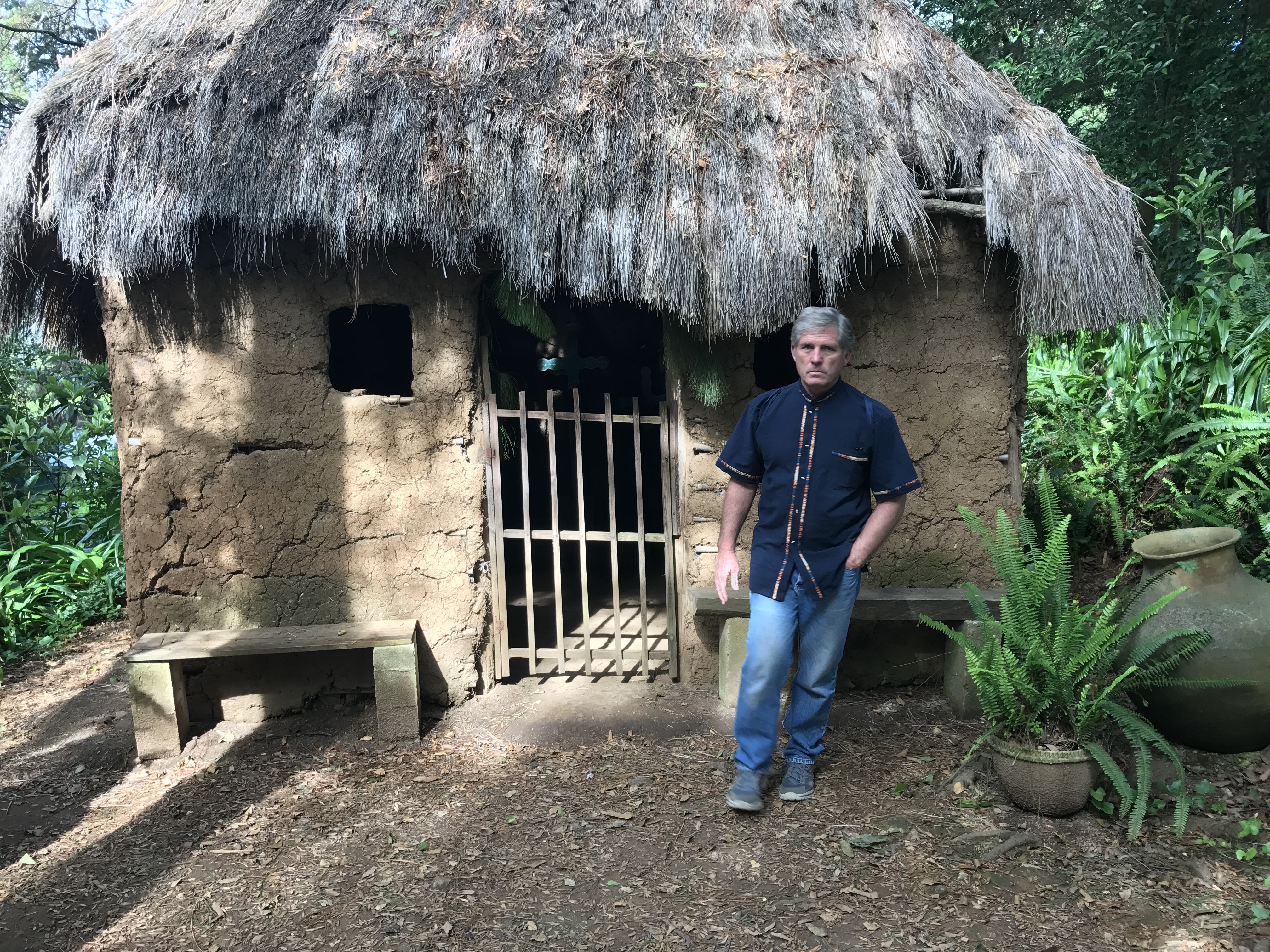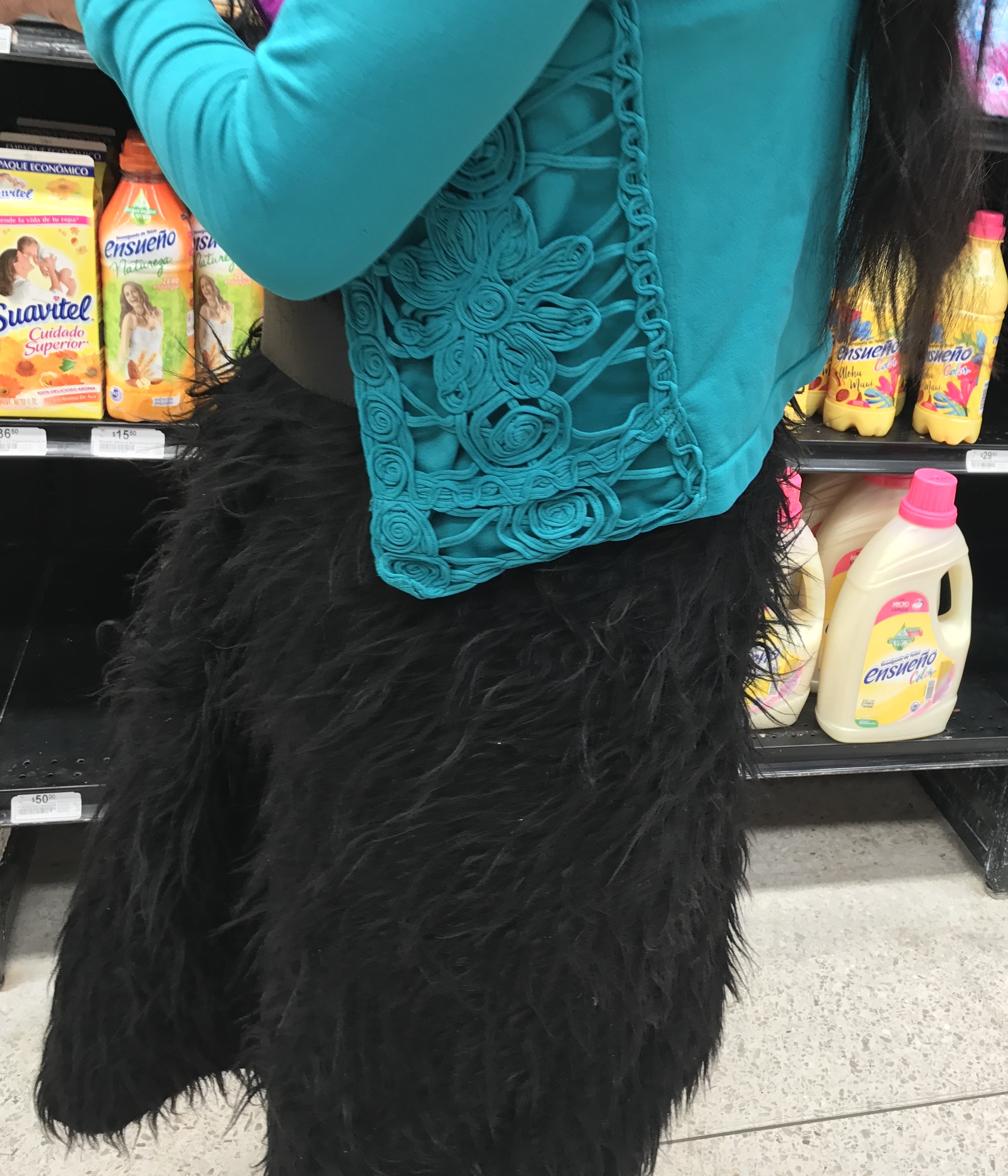After the low valleys and ocean roads of Chiapas, we were thrilled to climb into the mountains and experience San Cristobal de las Casas. This gorgeous mountain town is was once named San Cristobal, but later added the last name of a monk (Bartoleme de las Casas) to honor his work in protecting the Mayans from the Spaniards. This area has a long history of rebellion and unrest with an interesting blend of native peoples and immigrants to give the streets an exciting air. Restaurants, stands and shops range from traditional Mayan handcrafts to European bakeries and Mexican cafe’s. Truly an eclectic mix, with just enough strife to keep things interesting. The unrest is manifested in the graffiti, billboards and even the squatters who tent in the main plaza of the city. We found all of this to be quite intriguing and spent quite a bit of time in this temperate town.
 Our camper rolled into the campground called Rancho San Nicolas and settled in comfortably under the trees. There were several other travelers in this location. Almost immediately it was discovered that Mike knew a few things about Volkswagens, and he was put to work on a nearby camping rig.
Our camper rolled into the campground called Rancho San Nicolas and settled in comfortably under the trees. There were several other travelers in this location. Almost immediately it was discovered that Mike knew a few things about Volkswagens, and he was put to work on a nearby camping rig.  While he was doing that, the dogs made friends with the resident puppy, Mulan. Although Mango was not impressed with the wrestling, Zeb and Mulan spent hours each day rolling around in the grass and chasing each other across the property!
While he was doing that, the dogs made friends with the resident puppy, Mulan. Although Mango was not impressed with the wrestling, Zeb and Mulan spent hours each day rolling around in the grass and chasing each other across the property! 
 Each day we walked the easy stroll into town to visit bakeries, ethnic restaurants from around the world and a bookstore with English books! The street cafes were inviting, and the coffee was delicious.
Each day we walked the easy stroll into town to visit bakeries, ethnic restaurants from around the world and a bookstore with English books! The street cafes were inviting, and the coffee was delicious.  As we wandered around town over the period of a week or so, we became more aware of the indigenous people in the city. They sat outside the social services building, they walked the plaza area, selling their wares and they spent their money at the supermarket. All of their daily activities were done while wearing the proud colors of their villages. The women wear brightly colored tops with hand embroidered flowers, and usually the black fur skirts, wrapped and belted to simulate the hide of a wooly sheep. The women wore rebozos (long colorful scarves) which were used to carry babies, tied over their shoulders.
As we wandered around town over the period of a week or so, we became more aware of the indigenous people in the city. They sat outside the social services building, they walked the plaza area, selling their wares and they spent their money at the supermarket. All of their daily activities were done while wearing the proud colors of their villages. The women wear brightly colored tops with hand embroidered flowers, and usually the black fur skirts, wrapped and belted to simulate the hide of a wooly sheep. The women wore rebozos (long colorful scarves) which were used to carry babies, tied over their shoulders. 


The indigenous groups of this region of Chiapas are an important part of the cultural mix in this state. They have fought hard for their voices and continue to work to make sure the rights of all the small villages are represented. One recent struggle has been in the area of education. The groups have worked to ensure fair pay for teachers and to resist the forced changes to adopt a nationalized curriculum. These struggles have resulted in violence and publicity for the cause. This graffiti illustrates that battle.  The entire state of Chiapas struggles with an identity issue. On one hand the state wants to advance its people, bring in businesses and move ahead as a society. But within Chiapas there are many groups that oppose change and want to remain in practice with the old ways. Again we found this struggle illustrated in a beautiful street art depiction.
The entire state of Chiapas struggles with an identity issue. On one hand the state wants to advance its people, bring in businesses and move ahead as a society. But within Chiapas there are many groups that oppose change and want to remain in practice with the old ways. Again we found this struggle illustrated in a beautiful street art depiction.  Change has not come easily to this state. As we drove out of San Cristobal to see the waterfalls of Agua Azul, we encountered an interesting roadblock. Below you see a street sign, alerting us to a tope (a speed bump). Attached to the sign is a piece of rope.
Change has not come easily to this state. As we drove out of San Cristobal to see the waterfalls of Agua Azul, we encountered an interesting roadblock. Below you see a street sign, alerting us to a tope (a speed bump). Attached to the sign is a piece of rope.  As we approached, the rope was hesitantly raised and a couple walked towards the drivers door. They were holding a plastic bucket and this hand-lettered sign. It says, essentially that they need money to help get medical care for a child in their community. Passive and subtle, yet clearly inconveniencing to others to accomplish their goal. This is a good illustration of the struggles that take place daily across Chiapas.
As we approached, the rope was hesitantly raised and a couple walked towards the drivers door. They were holding a plastic bucket and this hand-lettered sign. It says, essentially that they need money to help get medical care for a child in their community. Passive and subtle, yet clearly inconveniencing to others to accomplish their goal. This is a good illustration of the struggles that take place daily across Chiapas.
Agua Azul was quite disappointing. Partly because the water was chocolaty brown from the recent rainstorms, and partly because the vendors in that area were pushy and aggressive with their pushy sales tactics . And the bugs were pretty bad, too. We had planned to camp there for a night, but felt unwelcome and chose to move on rather quickly. 
 As we headed back towards San Cristobal, we encountered another version of a roadblock. This time the woman was selling sugar cane. Her efforts to stop the truck consisted of standing in the middle of the road holding one end of a piece of string with fabric flags on it. Her children were on the side of the road with the bagged sugar cane. When it was clear that we were not stopping, she dropped the string and stepped aside. The hard sell, Chiapas style.
As we headed back towards San Cristobal, we encountered another version of a roadblock. This time the woman was selling sugar cane. Her efforts to stop the truck consisted of standing in the middle of the road holding one end of a piece of string with fabric flags on it. Her children were on the side of the road with the bagged sugar cane. When it was clear that we were not stopping, she dropped the string and stepped aside. The hard sell, Chiapas style. There are several museums in San Cristobal de las Casas which we felt were worthy of our time and energy. The Amber Museum was an interesting way to avoid a rainstorm for an hour, and we learned a few things about amber (Ambar in Español) The Nah Bolom Museum was an eclectic mess of archives, anthropology and indigenous information. Mike posed at the simulated Mayan hut in the back yard area.
There are several museums in San Cristobal de las Casas which we felt were worthy of our time and energy. The Amber Museum was an interesting way to avoid a rainstorm for an hour, and we learned a few things about amber (Ambar in Español) The Nah Bolom Museum was an eclectic mess of archives, anthropology and indigenous information. Mike posed at the simulated Mayan hut in the back yard area.  We also enjoyed the small but interesting Mayan Medicine Museum, although it could use a good dusting and some translation work. But the best museum of the entire city is the Mayan Textile Museum (Centro de Textiles del Mundo Maya). This museum brought Geneva back to visit two days in a row! The displays in the cases are interesting and beautiful. But the real treasures are stored in the archival drawers along the walls. When the drawer is opened, a blouse, huipil, shirt or other piece of handwork is revealed. And each piece has a card of information such as date, village, owner and who made the item. After a bit of reading (in Spanish) I was able to learn that the colors, patterns and weaves are specific to each village. Over generations these changed slightly – but generally if a certain village used pinks and reds, they have stayed with that for over a hundred years. This discovery helped me understand that the women in the photos above, could identify each other by just looking at the colors and patterns on their clothes! And the treasures in those drawers dated back to the early 1900’s!
We also enjoyed the small but interesting Mayan Medicine Museum, although it could use a good dusting and some translation work. But the best museum of the entire city is the Mayan Textile Museum (Centro de Textiles del Mundo Maya). This museum brought Geneva back to visit two days in a row! The displays in the cases are interesting and beautiful. But the real treasures are stored in the archival drawers along the walls. When the drawer is opened, a blouse, huipil, shirt or other piece of handwork is revealed. And each piece has a card of information such as date, village, owner and who made the item. After a bit of reading (in Spanish) I was able to learn that the colors, patterns and weaves are specific to each village. Over generations these changed slightly – but generally if a certain village used pinks and reds, they have stayed with that for over a hundred years. This discovery helped me understand that the women in the photos above, could identify each other by just looking at the colors and patterns on their clothes! And the treasures in those drawers dated back to the early 1900’s!
 We also encountered these funny signs near our campground, Rancho San Nicolas!
We also encountered these funny signs near our campground, Rancho San Nicolas!
 This man is talking on the phone while selling birds in cages on the street in San Cristobal. Each cage contains one or two small songbirds.
This man is talking on the phone while selling birds in cages on the street in San Cristobal. Each cage contains one or two small songbirds.
Back at Rancho San Nicolas the spider near our camper spun a lovely web using the edge of our camper and a large pine tree to brace his/her artwork! We met a lovely family from Brazil, with two children (one born on the road). They are also in a truck camper. Their son is a charming young man that is destined to be president someday! Here is amusing us while shopping at Chedraui. We feel fortunate to have crossed paths, as they are headed north now!
We met a lovely family from Brazil, with two children (one born on the road). They are also in a truck camper. Their son is a charming young man that is destined to be president someday! Here is amusing us while shopping at Chedraui. We feel fortunate to have crossed paths, as they are headed north now!  Although we did not eat here, the name of this restaurant caught my attention – My Old Love!
Although we did not eat here, the name of this restaurant caught my attention – My Old Love! 
 And every day, Zeb and Mulan wrestled around the property!
And every day, Zeb and Mulan wrestled around the property!
We enjoyed the rhythms and people of San Cristobal de las Casas. And although there was much to see around this part of Chiapas, we found ourselves wanting to stay here and relax (and play with the puppy). Watch to see what happens next, when we tried to leave!  Zeb says, “We have to leave?”
Zeb says, “We have to leave?”












Interesting point! We did enjoy the people as much as the location. But I can see how it could have easily changed when the crowd shifted.
It is still a wonderful area! We spent much time there.
I was visiting San Cristobal de las Casas in the Winter of 1968. It was one of the highlights of my trip to Mexico and am still remembering the Zocalo of San Cristobal, the visits to outlying Mayan villages with festivals and celebrations. Thanks for taking me down memory lane….
We really liked Rancho San Nicolas when we stayed there for a week on our way south. We stayed again heading north and confirmed that so much about a place is the people who are there. Our return visit had completely different residents (even dogs!) and we didn’t make the same connection. The lesson: you can’t go back. (But we still love San Cristobal!)